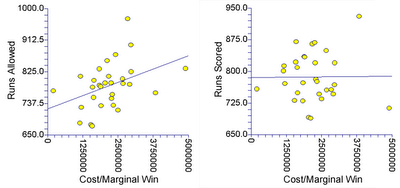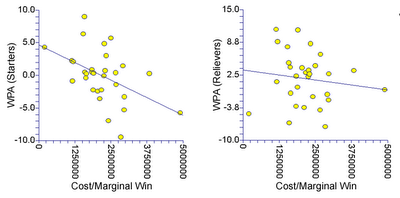First, for a general overview of the new agreement, I'll refer you to Brown's article at his new (free) Biz of Baseball website. He breaks it down into a number of categories. I want to give a brief comment on each component of the CBA, so I'll follow his lead below:
Revenue Sharing
Brown has an analysis of this online today for Baseball Prospectus subscribers. I admit that I don't really understand it all... but the main result of this process, as I understand it, is that revenue sharing has been adjusted to increase the incentives for teams to increase their revenue. Teams with increasing revenue over the 5-year period of this new agreement will be able to keep a larger amount of their new revenue than they would have under the previous agreement. And the best way to increase revenues is to increase the on-field team performance; therefore, the expectation is that this adjustment will mean that teams will invest more into player contracts and player development, rather than their owners' pockets.
For a team on the rise like the Cincinnati Reds (they have to be on the rise, don't they?), this could mean very good things through 2011. Of course, the flip side of all of this is that if you lose revenue over the five-year agreement, you're going to be feeling that revenue loss more than you would have in the prior agreement. So the Reds just need to make sure they keep gaining revenue. So win, dammit.
Competitive Balance Tax
I always thought that this tax was the limit to revenue sharing in baseball, but I apparently was wrong. The news here is that the threshold for when teams must pay this tax increases substantially over the next five years, moving from $136.5 million this year to $148 million in '07, and increases 5% each year to $178 million in 2011 when the agreement expires. That's a pretty hefty increase. Of course, the Yankee's end-of-year player payroll was an estimated $199 million, so maybe that doesn't matter, as it still will impact the worst offenders of payroll disparity. And that's all this tax is really designed to do.
Minimum Salary
Minimum salary for MLB players increases from the current $327,000 this year to $390,000, and gets a cost of living increase each year thereafter. That moves the marginal MLB team payroll (the minimum possible MLB payroll for a 25-man team) up from $8,175,000 to $9,750,000 next year. That's a $1.575 million increase, which more or less hits all teams across the board. Not a huge spike--I think that the Reds may have spent that much on players that they released this year--but small market teams who must rely on developing players for payroll reasons will feel this hike the most.
Draft Pick Compensation
Unlike prior reports, draft pick compensation for lost free agents has not been abolished, though it has been restricted. The number of type-A free agents that exist in the majors is decreased from 30% to 20%, Type-B free agents are no longer as costly (in terms of pick compensation) to sign, and Type-C free agents no longer entail compensation. The purpose of all of these adjustments seems to be to give incentives to teams to sign free agents--or not to let free agents leave in the first place. Nevertheless, I think the summed effect here is that small-market teams lose out on a valuable resource.
Amateur Draft
On the upside, there is apparently an improvement in the amateur draft system. The date by which a non-college senior must sign with the team that drafted them is moved up to August 15th of the prior year. Apparently this takes a big bite out of the bargaining power that these players can put on teams in terms of salary bonuses, based on this quote by badforthegame Scott Boras:
"On the draft side, high school players, particularly those who cannot attend college, are left with very little leverage."Why this is, I'm not sure. Maybe someone can explain it to me? I haven't been able to find anything more detailed on this issue. I'll post more on this when Maury Brown does (I hope) his detailed analysis on this issue at BP later this week.
--Boras
Free Agents
The various deadlines that restricted how long a team could negotiate with a free agent who had been on their team the previous year have been eliminated. I see this as a very good thing for small-market teams. Previously, if a team didn't arrive at an agreement with a player by January 8th, they could not field that player until mid-May of that year. While those rules were in place to avoid unfair bargaining practices, this allows additional flexibility for small market teams that are actively weighing their options near the end of the offseason.
Overall Themes
The overarching theme here is that that MLB expects player salaries, payrolls, and overall revenues to continue to increase. Baseball has a lot of cash right now, which is generally a good thing as it allows the industry as a whole to be generous and help pull up its weaker members (small market teams) with revenue sharing. I do have concerns that this could set a precedent that may be difficult to overcome in 2011, especially if baseball is unable to keep up the growth it's currently seeing. But the years under the previous agreement saw a U.S. economy that has been shaky to say the least, and have featured performance-enhancing drug scandals that raise questions about the legitimacy of on-field performance. And yet, baseball's business has been booming despite it all. Hopefully this will continue, and this new agreement will work to the Reds' advantage as they push forward under new management.





